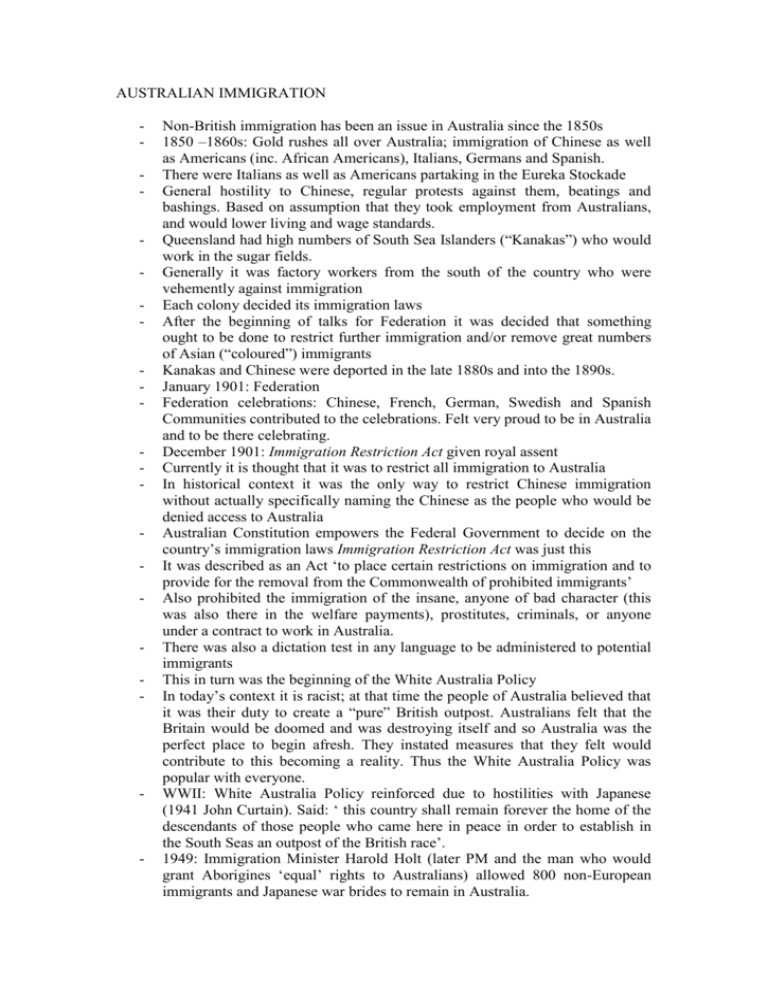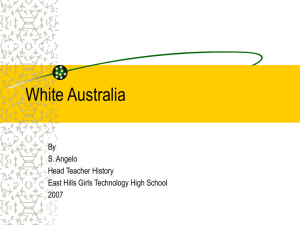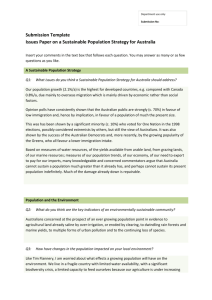AUSTRALIAN IMMIGRATION
advertisement

AUSTRALIAN IMMIGRATION - - - - - - - - Non-British immigration has been an issue in Australia since the 1850s 1850 –1860s: Gold rushes all over Australia; immigration of Chinese as well as Americans (inc. African Americans), Italians, Germans and Spanish. There were Italians as well as Americans partaking in the Eureka Stockade General hostility to Chinese, regular protests against them, beatings and bashings. Based on assumption that they took employment from Australians, and would lower living and wage standards. Queensland had high numbers of South Sea Islanders (“Kanakas”) who would work in the sugar fields. Generally it was factory workers from the south of the country who were vehemently against immigration Each colony decided its immigration laws After the beginning of talks for Federation it was decided that something ought to be done to restrict further immigration and/or remove great numbers of Asian (“coloured”) immigrants Kanakas and Chinese were deported in the late 1880s and into the 1890s. January 1901: Federation Federation celebrations: Chinese, French, German, Swedish and Spanish Communities contributed to the celebrations. Felt very proud to be in Australia and to be there celebrating. December 1901: Immigration Restriction Act given royal assent Currently it is thought that it was to restrict all immigration to Australia In historical context it was the only way to restrict Chinese immigration without actually specifically naming the Chinese as the people who would be denied access to Australia Australian Constitution empowers the Federal Government to decide on the country’s immigration laws Immigration Restriction Act was just this It was described as an Act ‘to place certain restrictions on immigration and to provide for the removal from the Commonwealth of prohibited immigrants’ Also prohibited the immigration of the insane, anyone of bad character (this was also there in the welfare payments), prostitutes, criminals, or anyone under a contract to work in Australia. There was also a dictation test in any language to be administered to potential immigrants This in turn was the beginning of the White Australia Policy In today’s context it is racist; at that time the people of Australia believed that it was their duty to create a “pure” British outpost. Australians felt that the Britain would be doomed and was destroying itself and so Australia was the perfect place to begin afresh. They instated measures that they felt would contribute to this becoming a reality. Thus the White Australia Policy was popular with everyone. WWII: White Australia Policy reinforced due to hostilities with Japanese (1941 John Curtain). Said: ‘ this country shall remain forever the home of the descendants of those people who came here in peace in order to establish in the South Seas an outpost of the British race’. 1949: Immigration Minister Harold Holt (later PM and the man who would grant Aborigines ‘equal’ rights to Australians) allowed 800 non-European immigrants and Japanese war brides to remain in Australia. - - 1957: non-European immigrants who had lived in Australia for at least 15 years were allowed to become Australian citizens 1958: Dictation test abolished and Migration Act passed to make it easier to remain or immigrate to Australia 1966: beginning of skilled migrants scheme whereby any person with a good character, readiness to integrate and a trade or profession that was positively useful to Australia was accepted Citizenship laws changed: now required 5 years of residence March 1966: White Australia Policy abolished Yearly non-European settler arrivals rose from 746 in 1966 to 2696 in 1971, while yearly part-European settler arrivals rose from 1498 to 6054. 1973: Whitlam government removed further race barriers These were to: - - - - legislate that all migrants, of whatever origin, be eligible to obtain citizenship after three years of permanent residence issue policy instructions to overseas posts to totally disregard race as a factor in the selection of migrants and ratify all international agreements relating to immigration and race. But Whitlam government reduced the number of accepted immigrants Increase in non-European immigrants did not occur until the Fraser government in 1975 An average net population gain of 70,000 was forecast for the first triennium 1978-81 and it was estimated that the new policy would contribute to raising Australia's population to about 19 million by 2001. Almost one in four of Australia's 20 million people was born overseas. In 2001-02 the number of arriving settlers totalled 88 900. They came from more than 150 countries, including New Zealand (17.6 per cent), the United Kingdom (9.8 per cent), China (7.5 per cent), South Africa (6.4 per cent), India (5.7 per cent) and Indonesia (4.7 per cent). Under Hawke/ Keating government the policy of reuniting families was begun Government would fund the reuniting of families for people from Asia However, Hawke said that immigration should be stemmed in the cause of social cohesion Following 1996 the emphasis on the Asia-oriented foreign policy (and subsequent immigration policy) gradually began to recede as a conservative government came to power. Almost immediately following Howard’s election win Pauline Hanson made her maiden speech (10 September 1996) Hanson claimed that Australia was going to be swamped by Asians She also wanted the government to bring “preferential treatment” to Aborigines to an end claiming that it was leading to separatism. Intensified simmering racial tensions in the community with these comments Speech came when Australia was trying to integrate with Asia (as per Keating’s view of Australia’s place in the world). She gained support from those who believe that Australia’s open economic policy is making the lives of ‘Australians’ worse - - - - - - - - - Aiming to cut Australia's immigration influx from 83,000 in 1995-1996 to 74,000 in 1996-1997, the government proposed a reduction of slots for applicants applying under the family immigration program. Howard did nothing to publicly condemn Hanson’s views but cut immigration numbers substantially The 2001 federal election was run on the two issues of immigration and terrorism. An issue has always been the so-called boat people who are illegal immigrants entering Australian waters in generally overcrowded and unseaworthy boats Generally these came via the Christmas Islands from Indonesia Before 2001 the illegal immigrants would be transported to Australia and housed in detention centres- the most (in)famous being Baxter in SA, and at Woomera. Apparently conditions in these centres defy human rights conventions Prior to the 2001 elections two incidents occurred- Tampa and the Children Overboard (Siev X). Tampa was the name of the Norwegian freighter which picked up asylum seekers close to Christmas Island in September 2001 Due to international law survivors of a shipwreck must be taken to the nearest port which in this case was Christmas Island which is Australian territory However, the Australian government refused to allow ‘Tampa’ to dock and unload the survivors because they claimed that C.I did not have the facilities for the ship to dock and because the rescue had taken place in Indonesian waters they should go there instead The captain of the ship (after a standoff of 3 days) declared an emergency and proceeded to enter Australian waters. The SAS (Special Air Service) were sent in and boarded the ship to prevent it from entering Australian territorial waters The Australian government was seeking to stop any of the asylum seekers from applying for asylum, which they could legally do as soon as they stepped foot on Australian territory. Australia tried to force it back into international waters but Norway warned Australia against that action. Indonesia and Norway both refused to accept the asylum seekers. NZ accepted them. Aus. Received support from the UK for this move Up 90% of people agreed with the government Howard’s slogan: “we decide who comes into this country and the circumstances in which they come” After Sept. 11 it was applauded Children Overboard took place in October 2001 Peer Reith (the then defence minister) claimed that illegal immigrants on the SIEV (suspected illegal entry vessel) X boat people were throwing their children overboard in order to stop the boat from sinking. He claimed to have photographic proof of this It too was heading for C.I Senate committee discovered that the claim was untrue and the government knew of this prior to the fed. Election and had lied to the electorate Mandatory detention is still a current policy of the government whereby all asylum seekers and illegal immigrants are detained in centres until their cases are investigated Some people are detained for 6-7 years - - - Recently changes were demanded by Petro Georgio and introduced by Howard following the Cornelia Rau affair when an Australian permanent resident (or citizen?) was detained for 8 months in two of these centres 50 Australian citizens have suffered the same fate Department of Immigration, Multicultural and Aboriginal Affairs say that there is nothing wrong with mandatory detention and that it is not their job to identify people but people’s job to identify themselves. Vanstone has been pressured to resign but has not. Palmer Inquiry also delved into the case of Vivian Solon The Inquiry did not have the power of a Royal Commission and as such proved ineffective though it did condemn the mand. Detention system Most children were released from the centres Children also receiving an education while there Quicker investigation of cases has been promised Currently the government is returning to the stance that skilled migrants should be allowed into the country in high numbers. New immigration level of 90,000 people per year.






